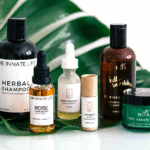If you have oily skin, you’re no stranger to shiny foreheads, clogged pores, or surprise breakouts. But with the right skincare products, oily skin can look balanced, clear, and healthy. The challenge is figuring out which products help and which ones make things worse.
Oily skin is caused by overactive sebaceous glands that produce excess sebum. While sebum helps protect and hydrate your skin, too much of it can lead to greasiness, enlarged pores, and acne. That’s why using the right skincare routine is essential—not just for managing oil but also for preventing long-term skin issues.
In this guide, you’ll learn how to choose the best skincare products for oily skin, which ingredients to look for, and what to avoid so you can build a routine that truly works.
Understand Your Skin Type
Before diving into products, be sure you actually have oily skin. Common signs include
Your skin looks shiny or greasy, especially in the T-zone
You often have clogged pores or blackheads
Your makeup slides off during the day
You’re prone to breakouts
If you experience these signs consistently, you likely have oily skin. Some people also have combination skin, which means they have oily areas and dry patches. It’s important to know the difference so you don’t over-treat your skin and cause more problems.
Key Features to Look for in Products
When shopping for skincare products for oily skin, focus on these features
Non-comedogenic This means the product won’t clog pores, which is crucial for oily or acne-prone skin
Oil-free Products labeled as oil-free won’t add extra greasiness to your face
Lightweight formulas Gels, foams, and water-based products absorb better and feel lighter on oily skin
Mattifying or oil-control properties These help keep excess shine under control throughout the day
Fragrance-free or gentle formulas Fragrances and harsh chemicals can irritate skin and cause excess oil production
Step-by-Step Skincare Routine for Oily Skin
Here’s how to build a basic yet effective skincare routine using the right types of products
Cleanser
Use a gentle foaming or gel-based cleanser twice a day. Avoid harsh soaps or bar cleansers, which strip natural oils and trigger more oil production.
Look for ingredients like salicylic acid, tea tree oil, or glycolic acid that help clear pores and reduce oil.
Good picks include
CeraVe Foaming Facial Cleanser
La Roche-Posay Effaclar Gel Cleanser
Neutrogena Oil-Free Acne Wash
Toner
Toner can help remove leftover dirt, balance your skin’s pH, and prep your skin for moisturizer.
Look for alcohol-free toners with ingredients like niacinamide, witch hazel, or green tea extract.
Avoid toners with high alcohol content—they may give a quick dry feeling but will worsen oiliness over time.
Serum
A good serum targets deeper skin concerns like acne, large pores, or inflammation.
Ingredients to look for in serums for oily skin include
Niacinamide Reduces oil and minimizes pores
Salicylic acid Clears blackheads and prevents breakouts
Hyaluronic acid Hydrates without clogging
Apply serums after toner and before moisturizer, usually at night or twice daily depending on the product.
Moisturizer
Yes, oily skin still needs moisture. Skipping moisturizer can cause your skin to overcompensate by producing more oil.
Look for oil-free, water-based, or gel moisturizers. Avoid rich creams and products with heavy oils like coconut or mineral oil.
Some great choices
Neutrogena Hydro Boost Water Gel
Simple Hydrating Light Moisturizer
Clinique Dramatically Different Oil-Free Gel
Sunscreen
Never skip sunscreen, even if you have oily or acne-prone skin. UV exposure can damage your skin barrier and increase oiliness.
Choose lightweight, non-comedogenic, and mattifying sunscreens.
Try
EltaMD UV Clear SPF 46
Neutrogena Clear Face SPF 55
La Roche-Posay Anthelios Clear Skin SPF
Optional Treatments
Exfoliants
Use a chemical exfoliant with BHA (like salicylic acid) 2–3 times a week to keep pores clean and control shine. Avoid gritty scrubs—they can irritate oily skin.
Clay masks
Use once or twice a week to absorb oil and tighten pores. Look for masks with kaolin clay, bentonite clay, or charcoal.
Spot treatments
Use products with benzoyl peroxide or salicylic acid directly on pimples to reduce inflammation.
Ingredients to Avoid
Knowing what not to use is just as important. For oily skin, avoid
Heavy oils like coconut oil, mineral oil, or lanolin
Alcohol-heavy products
Fragrance or artificial dyes
Thick creams and occlusives like petrolatum unless prescribed
These can clog pores, increase oiliness, or irritate your skin, causing more breakouts.
Budget-Friendly Tips
You don’t have to spend a lot to care for oily skin. Some of the best products are drugstore staples. Stick to simple, effective ingredients and avoid trends that promise quick fixes. Investing in a consistent routine pays off more than buying expensive one-time-use products.
Final Thoughts
Oily skin may seem tricky to manage, but with the right skincare products, you can keep oiliness under control and enjoy a balanced, clear complexion. Focus on oil-free, non-comedogenic products with gentle, active ingredients like salicylic acid, niacinamide, and lightweight moisturizers. Build a routine around cleansing, hydrating, and protecting your skin every day—and stay consistent.
With time and the right care, oily skin can be one of the easiest types to maintain because it naturally resists aging and dryness. Treat it with balance, not harshness, and you’ll see results.
Frequently Asked Questions (FAQs)
1. Can oily skin use moisturizer?
Yes. Oily skin still needs hydration. Use lightweight, oil-free moisturizers to balance your skin and prevent overproduction of oil.
2. How often should I wash my face if I have oily skin?
Twice a day is ideal. Over-washing can strip your skin and trigger more oil production.
3. Which ingredients help reduce oily skin?
Salicylic acid, niacinamide, witch hazel, clay, and zinc are all great ingredients to manage oil.
4. Are natural products better for oily skin?
Not always. “Natural” doesn’t mean non-comedogenic. Always check labels for pore-clogging ingredients.
5. Can sunscreen make oily skin worse?
Only if you use the wrong one. Choose lightweight, non-comedogenic sunscreens designed for oily or acne-prone skin.







